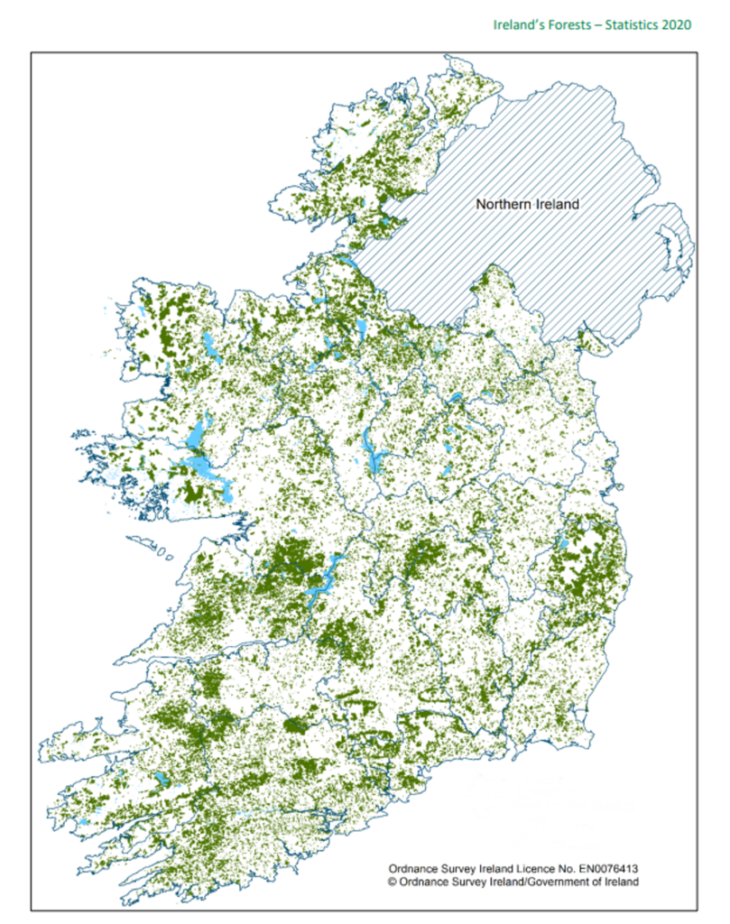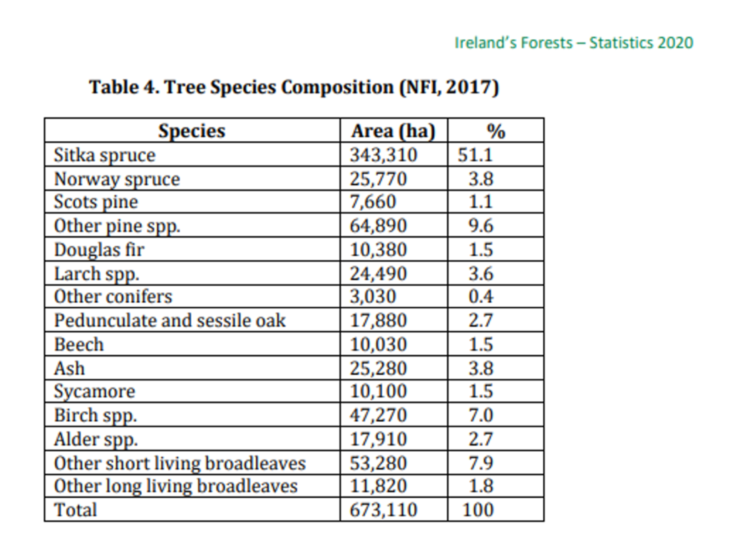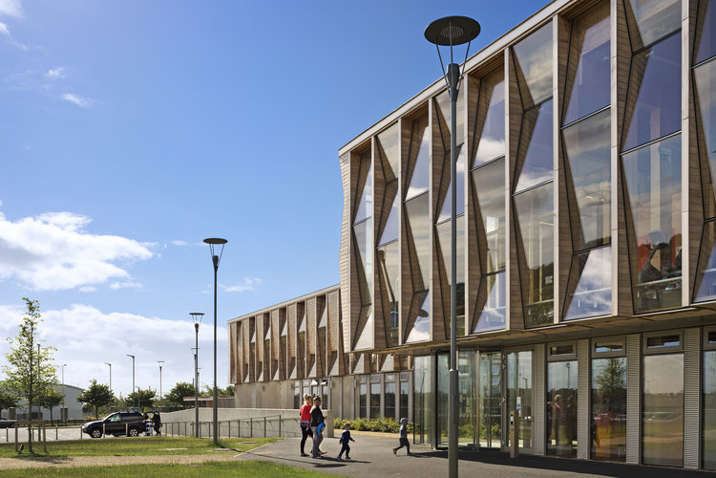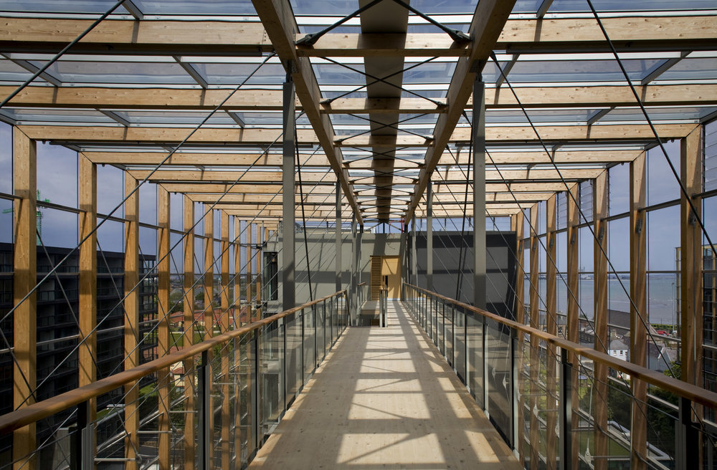
Ireland’s forest cover – Annual statistics 2019. Source
https://www.teagasc.ie/media/website/crops/forestry/advice/Forest-Statistics-Ireland-2020.pdf
Irish architecture dates as far back as the Stone Age, and in its history, has seen strong influences from Norman and Anglo-Irish societies in their castles to Georgian buildings and landscape. Concrete has been the dominant construction material and dates as far back as 1850 due to its local availability as well as durability. However, due to climate change, the construction industry and its materials preferences must change in order to mitigate the impacts of climate change. Concrete accounts for approximately 8% of global CO2 emissions worldwide. This coincides with the fact that Ireland’s population of 5 million in 2020, is projected to reach 6 million by 2050. This will put further strain on the construction industry that must accommodate a growing population, while minimizing its impact on climate change. There has been a shift in mindset in Ireland, and timber construction has made small incremental steps as a viable alternative to concrete. However, it is still heavily disadvantaged to more easily accessed and cheaper concrete. Data provided by the latest Central Statistics office in 2020, reveal just 11.2% of Ireland’s total land area was covered by forestry, making it the third-lowest proportion across the 28 EU states. Sweden’s forests make up approximately 68.95% of its land, allowing for timber construction to thrive and become the source of materials for construction. Government initiatives and grants to plant approximately 22 million trees a year, and over 400 million trees by the year 2040, will allow for Ireland’s forestry industry to fully embrace a timber construction industry relying on Irish produced mass timber products rather than having to rely solely on imported timber or mass timber products from abroad. This paper hopes to highlight how it is essential to incorporate mass timber construction into the Irish construction industry in order to reduce both its reliance on concrete as well as providing a more sustainable and environmentally friendly alternative.
A report in August 2021 by the Intergovernmental Panel on Climate Change, announced that deforestation is a major contributor to the increased presence of CO2 in the air over the past decade, a rise incomparable to any other period in the past two million years. The panel also confirmed that it is “almost inevitable” that air temperatures will surpass the 1.5? threshold set out by the 2015 Paris Agreement which is believed to be the tipping point for climate change that may be impossible to recover. Ireland once possessed 80% forest cover and it was said that “a squirrel could travel from one end of Ireland to the other without ever touching the ground”. However, with the introduction of Neolithic farmers and the increase in Ireland’s population and industry, the tree cover was reduced from 80% to a miniscule 1%. Ireland is committed to “halving greenhouse gas emissions by 2030 and reach net zero by 2050”, and identifies afforestation as the “single largest land based climate change mitigation measure available to Ireland”. The 2019 plan aimed to plant, on average, 8000 ha per annum of newly planted forests. However, it is believed that approximately 16,000 ha per annum of new forests must be planted in order to achieve carbon neutrality.
However, while the shift has been slow and gradual in Ireland, with reports stating that Ireland is “60% behind the governments forest cover schedule”. Prof. John Fitzgerald, who is a member of the Climate Change Advisory Council, claims that a significant increase in tree planting could sequester 100 million tons of carbon dioxide by 2050. He also explained that at the price the government recommends for CO2, this carbon fixed in additional forestry would be worth €26.5 billion to the country – before the value of the timber produced is included. Up until the late 1980’s, the majority of forests in Ireland were owned and cared for by the state. This situation changed in the 1990’s when grants and funding was provided to promote afforestation in both public and private plots of land. Private planting increased mostly amongst farmers, but also by some individuals with significant plots of land. This had the effect of shifting the ownership pattern significantly and by 2007 57% of forests were owned by the State and 43% by private individuals and companies.
Sitka Spruce
As timber production was the main objective of the government and forestry agencies following the almost complete deforestation of the country, a North American conifer species were seen as a solution to creating a productive forest resource well able for the Irish climate in only a short period of time. These species came to dominate plantations to such an extent that by the 1980s the state forests were approaching a conifer monoculture. Sitka spruce was a particularly successful species and well suited to the Irish climate due to its fast growth rate, resistance to climatic conditions, and ability to thrive on the damp and mountainous soil conditions. The species was so successful that by the late 1980s it formed approximately 85% of all trees planted annually throughout Ireland. Approximately 90% of the timber harvested throughout Ireland, utilizes timber sourced from Sitka spruce forests and many diverse products are produced, ranging from pallets and packaging to timber fencing and construction timber. While Sitka spruce has played a key role in repopulating forests throughout Ireland, concern was expressed about the dangers of relying too heavily on one species, particularly a non-native species that could be vulnerable to an introduced insect pest or disease for which it may not have resistance.

While it is clear to see that Ireland has been lagging behind Europe in terms of forest planting and implementing policies to promote more forest cover throughout the island, Ireland has begun to take the necessary steps to make a lasting change in both its policies and strategy in combating climate change. Below are two examples of mass timber construction within Ireland which show the shift to more sustainable and environmentally friendly designs. With every building and design completed, the more CLT and other mass timber products can shift the construction focus to more sustainable designs and materials.

Samuel Beckett Civic Campus, Dublin – Bucholzmcevoy Architects. Source
https://www.bmcea.com/samuel-beckett-civic-campus/nuw0qujbhl208nbdw12mwtzk7d4v1j

Elm Park Mixed Use Development, Dublin – Bucholzmcevoy Architects. Source
https://www.bmcea.com/elm-park-green/e1bw2cv0f4kvda22ay6ve3h6dcnm3e